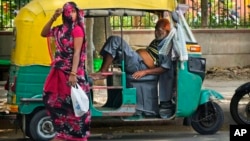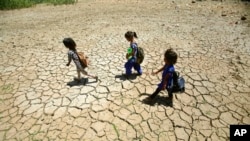Heat waves like the ones roasting South Asia this year don't just sap people's strength. They drain people's finances in ways that are not always obvious.
It's one of the ways climate change is weighing on the economy and making poor people poorer.
"These effects are global, they are pronounced, and they are persistent," said Teevrat Garg, an economist at the University of California-San Diego’s School of Global Policy and Strategy.
South Asia is especially vulnerable to the impacts of climate change-driven heat waves. But temperature extremes are becoming more common worldwide as the planet warms.
1. Too hot to work
March and April were the hottest or near-hottest months on record across South Asia.
Climate change made this heat wave about 100 times more likely, according to the U.K. Met Office.
The heat has been brutal for farmers, construction workers and anyone who has to work outside. That's about half the workforce in South Asia.
"Wage laborers like us work despite the heat," Indian construction worker Kushilal Mandal told Agence France-Presse in April. "We won’t be able to eat if we don’t work."
At these temperatures, heatstroke and even death are real risks.
Many work sites shut down early. But that means lost wages.
The U.N. International Labor Organization says that in 2030, hours lost to heat worldwide will be the equivalent of losing at least 80 million full-time jobs.
2. Lower earnings for outdoor work
It doesn't take a full work stoppage to hurt workers' wages. People just can’t do as much when it's hot.
In a study Garg co-authored, workers in Indonesia in a hot, sunny environment were 8% less productive than those in a shady environment that was about 3 degrees cooler. Doubling wages did not increase productivity.
"It's not about workers feeling icky or lazy or just like, 'I don't want to work because it's hot,' " Garg said. "It's that heat is representing binding constraints on workers' ability to do their job."
3. Factory slowdowns
Heat affects workers even if they are not exerting themselves. High temperatures slow down factory workers, too.
"We think of manufacturing as a thing that occurs inside. But inside doesn't mean protected from heat. It doesn't mean air conditioning," said World Bank economist Patrick Behrer.
Studies as far back as 1915 show factory workers paid by the piece earn less at higher temperatures. Even call center workers get less done in hot conditions.
"It's harder for you to pay attention. It's harder for you to focus. You get tired more easily," Behrer said. "All of those things feed through to reductions in productivity."
4. Workplace injuries
More than wages can be at risk.
"Because you're paying less attention to what you're doing or you're more tired, you're much more likely to injure yourself," Behrer said.
On very hot days, workers are about 10% more likely to be injured on the job than on a cool day, Behrer and colleagues found in a study.
That could mean lost wages for the day, or it could be more serious. "If you get hurt on the job, that can be a permanent change in your life," Behrer said.
5. Poverty traps
Poorer areas are more vulnerable to the impacts of rising temperatures than wealthier areas, researchers have found. Workers tend to be in industries that are more exposed to heat. And poor people often can't afford air conditioning. These inequalities are expected to worsen with global warming.
High temperatures also lower crop yields, which lower household incomes in largely agrarian economies such as those of South Asia.
The effects can be passed on to children in these rural households. Garg and colleagues found that students score lower on math and reading tests the year after a hot year, perhaps because their families had less money to spend on education, or even on food or health.
Adaptation
Societies can adapt to hotter temperatures. Factories, for example, can buy air conditioning.
But that's money they won't spend on better equipment or hiring more workers, Garg noted.
"Adaptation is not free. It's expensive. It's costly," he said. "And in general we find that the poorer you are, the more expensive it is."
Social safety net programs can help. Garg and colleagues, for example, conducted a study focused on a safety net program in India that supplemented income in rural areas. Since heat waves did not affect farm households’ budgets as much, the effect of heat on students’ test scores was smaller.
With heat waves becoming more common, demand for safety-net programs is growing.
"Countries are already paying for climate change," Garg said, "because the demand on social protection is rapidly increasing as we get more and more hot days."
"When we think about climate investments, [typically] we're thinking about seawalls and green energy. And all of that's quite important. But ... safety net [programs] are going to play a huge role for low- and middle-income populations," he said.


